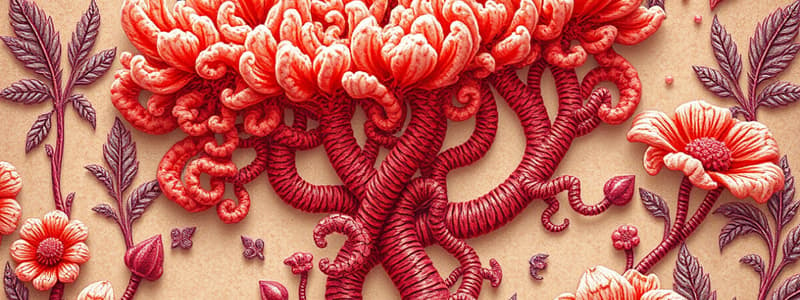Podcast
Questions and Answers
What are the general characteristics of Nocardia species? (Select all that apply)
What are the general characteristics of Nocardia species? (Select all that apply)
- Obligate aerobe (correct)
- Catalase positive (correct)
- Gram negative filamentous rod
- Weakly acid fast (correct)
How does acid fast staining work?
How does acid fast staining work?
It uses carbol fuchsin stain that's taken up by bacteria with mycolic acids in their cell wall.
What is the method of transmission for Nocardia species?
What is the method of transmission for Nocardia species?
Found in soil and associated with activities that allow dirt to get into wounds.
Which groups are at risk for nocardiosis? (Select all that apply)
Which groups are at risk for nocardiosis? (Select all that apply)
What are the clinical presentations/complications of nocardiosis?
What are the clinical presentations/complications of nocardiosis?
What activities can cause cutaneous nocardiosis?
What activities can cause cutaneous nocardiosis?
What is the treatment for nocardiosis?
What is the treatment for nocardiosis?
What is the mnemonic for differentiation of treatment between Nocardia and Actinomyces?
What is the mnemonic for differentiation of treatment between Nocardia and Actinomyces?
Flashcards are hidden until you start studying
Study Notes
General Characteristics of Nocardia Species
- Gram-positive filamentous rods that are obligate aerobes.
- Catalase and urease positive, exhibiting weak acid-fast properties.
Acid Fast Staining Process
- Involves using the carbol fuchsin stain, which is absorbed by bacteria with mycolic acids in their cell walls.
- Mycolic acids consist of long-chain fatty acids characterized by two tails.
Transmission Methods for Nocardia Species
- Primarily found in soil; does not form spores, unlike many other bacteria.
- Cutaneous nocardiosis is linked to activities where soil can enter wounds, such as gardening or construction.
At-Risk Populations for Nocardiosis
- Mainly affects immunocompromised individuals and shows a higher prevalence in men compared to women.
Clinical Manifestations and Complications
- Pulmonary: Presents as pneumonia with cavitary lung lesions.
- CNS: Can lead to brain abscess formation.
- Cutaneous: Results in indurated lesions accompanied by inflammatory reactions.
Causes of Cutaneous Nocardiosis
- Increased risk from activities that expose skin to soil, such as gardening, construction, and accidents.
Treatment Options for Nocardiosis
- Sulfonamides are the primary treatment method for infections caused by Nocardia.
Treatment Differentiation Mnemonic
- Use the mnemonic "SNAP" to remember: Sulfonamides for Nocardia, Penicillin for Actinomyces.
Studying That Suits You
Use AI to generate personalized quizzes and flashcards to suit your learning preferences.




